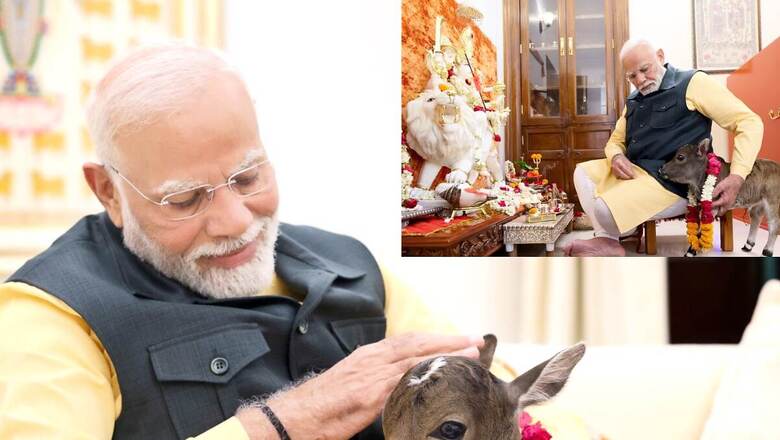
views
The heartwarming picture of Prime Minister Narendra Modi playing with a calf from the Punganur cow breed has Andhra Pradesh bursting with pride.
“It’s a reflection of India inside the Honourable Prime Minister’s residence. The cow was chosen by the PM’s office, but we are really excited to see the pride of Andhra Pradesh at his residence,” Andhra Pradesh’s IT minister Nara Lokesh told News18.
Once near extinction, the Punganur cow is a rare breed now receiving significant attention, especially since PM Modi is known to rear a few of them at his official residence. It is reported that PM Modi enjoys feeding and playing with them, as seen in several videos released by the PMO.
EXTINCTION THREAT TO MISSION PUNGANUR
This dwarf breed, native to the village of the same name in Andhra Pradesh, can even be reared inside an apartment. Known to be among the world’s smallest humped cattle breeds, it stands 80-90 cm tall (a maximum of 2.5 feet) and can weigh up to 200 kg at peak health.
This breed faced the threat of extinction when farmers prioritised higher milk production, and their number was reduced to just 100 across the country. The Punganur cattle could not match the milk output of hybrid cows, and, suddenly, they were seen as a liability, leading farmers to sell or abandon them.
हमारे शास्त्रों में कहा गया है – गाव: सर्वसुख प्रदा:'। लोक कल्याण मार्ग पर प्रधानमंत्री आवास परिवार में एक नए सदस्य का शुभ आगमन हुआ है।
प्रधानमंत्री आवास में प्रिय गौ माता ने एक नव वत्सा को जन्म दिया है, जिसके मस्तक पर ज्योति का चिह्न है।
इसलिए, मैंने इसका नाम 'दीपज्योति'… pic.twitter.com/NhAJ4DDq8K
— Narendra Modi (@narendramodi) September 14, 2024
The Andhra Pradesh government later launched Mission Punganur, aimed at increasing awareness and conserving the breed. With special focus from both the state and the Centre, the breed now has a healthy population across the country.
‘GOLDEN MILK’, COSTS Rs 1-10 LAKH
Aside from its unique form and size, the milk from the Punganur cow is known for its high nutritional value, being four times richer than milk from other cow breeds. This is due to the presence of ‘Au’, the chemical symbol for gold, in its milk, according to Dr B.L. Chidananda, a retired professor of Animal Sciences from the University of Agricultural Sciences, GKVK. That is why this “golden” milk from this cow is offered to deities during “Ksheera-abhishekham” (milk offering) across Andhra Pradesh, including Lord Venkateswara at the famous Tirupati Thirumala Temple.
Dr Chidananda explains that the Punganur cow’s milk, known as A2 milk, is rich in nutrients like Omega fatty acids, calcium, potassium, and magnesium, bringing its milk fat content to 8%, compared to milk from other cows, where the fat content is around 4%.
“These nutrients are essential for maintaining good health, and the richness of the milk makes it highly valuable,” he said.
According to dairy farmers who rear Punganur cattle in Andhra Pradesh, this special cow can produce up to three litres of milk per day, unlike other hybrid breeds, which can give up to 20 litres a day.
Admired for its beautiful face and eyes, which are said to appear as though lined with “kohl” (kajal), the Punganur cow is also regarded as “divine” by those who breed them. Known for their calm and friendly nature, they are especially gentle with children, making them an ideal pet for families, according to experts who encourage adopting the breed.
A new member at 7, Lok Kalyan Marg! Deepjyoti is truly adorable. pic.twitter.com/vBqPYCbbw4
— Narendra Modi (@narendramodi) September 14, 2024
The presence of a cow is of great significance in India, and owning a Punganur cow is considered a symbol of prestige. Rearing cows is believed to bring prosperity, compassion and good fortune, and having a Punganur cow makes it even more special.
The cost of a Punganur cow can range from Rs 1 lakh to Rs 10 lakh, depending on the size and health of the cow. They are often reared in Andhra Pradesh by temples, goshalas and landowners.




















Comments
0 comment